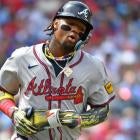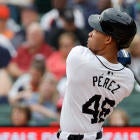Last week we took the shrink wrap off the 2010 model of our Lucky/Unlucky batters' analysis. We've given starting pitchers a week to put on their best face, but now here comes the scrutiny. The visualization and analysis that follows can help you to sort out which hurlers look poised for a fall, which are set to surge, and which have set a level where they are likely to stay for the season.
We will start our analysis of 2010 pitching data with a focus on a dozen starters who have produced some surprising Fantasy stats. There are plenty of other intriguing statistical stories out there, so use the tool to find them and reach your own conclusions.
Players' stats are for all games played through Sunday, May 9.
Who has probably been lucky?
Dallas Braden, Oakland: Where else is there to start than with the Pride of the 209 area code? There is nothing like a perfect game to boost one's stats, and Braden's ERA dropped from 4.14 to 3.33 just over the course of this one performance. He has been underrated for some time, but with the hype that his perfecto is likely to generate, owners may expect Braden to be as good as his ERA says he is going forward. Normally, he is a flyball pitcher, but in giving up far more line drives and grounders this year, Braden is fortunate to be sporting a .243 BABIP. His ERA and WHIP will probably rise no matter what, but the increase could be sharp if he doesn't start allowing more flies. Pitching half of his starts in Oakland, there isn't much risk in having him revert to his flyball tendencies.
Mike Leake, Cincinnati: He hasn't been the most lauded member of this year's rookie class, but Leake has been a quiet sensation, growing in popularity among owners each of the last few weeks. He has been surprisingly effective, especially for a pitcher with no minor league experience, but he has been pitching a bit over his head. For all of the ground balls and walks that Leake has allowed, a 1.20 WHIP seems unsustainable. Other groundballers, like Tim Hudson and Chris Volstad, have been getting some help from very low line drive rates, but Leake's .259 BABIP looks especially fluky. All three of these ground ball pitchers appear due for some rougher times ahead, but Leake's fall could be the most precipitous.
Doug W. Fister, Seattle: We don't need to do a BABIP analysis to know that Fister won't maintain a sub-2.00 ERA, but I have included him here because he has probably been the luckiest pitcher this side of Livan Hernandez (.182 BABIP). The second-year pitcher has line drive and flyball rates that would make him a candidate for an above-average BABIP, not one that is more than 70 points below the current major league average. According to the Fangraphs website, Fister has the third highest rate of allowing contact on swings in the majors, so an impending increase in BABIP could have an especially harsh impact on his Fantasy value.
Ryan Rowland-Smith, Seattle: Fister is not the only candidate to regress on a Mariners staff that is third in the American League in ERA. Rowland-Smith has a .248 BABIP despite owning the highest line drive rate among American League starting pitchers. The worst part of it is that he has needed all of this good luck just to get his ERA down to 6.21. He is capable of much better, but with Erik Bedard and Ian Snell lurking as possible replacements, Rowland-Smith doesn't have long to turn things around.
Who has probably been unlucky?
Rick Porcello, Detroit: Owners have been bailing on Porcello, and he is now available in more than two-fifths of all leagues on CBSSports.com. You have a golden opportunity to get a quality starter on the cheap, as Porcello should have even better Fantasy stats than he had last year. He is striking out more batters and posting a miniscule line drive rate, but a .398 BABIP has wreaked havoc on his value so far. The Tigers lineup is scoring some runs, so it's worth it to take the time to pick Porcello up or offer a trade for him.
Doug Davis, Milwaukee: Davis' 8.13 ERA is even uglier than Porcello's, but like the Tigers' righty, he deserves to have some pretty good Fantasy stats. He is striking out more than a batter per inning while taking his walk rate down a peg. Davis' strikeout rate will probably tail off some, and he is too wild to be relied upon for mixed leagues, but contrary to what his ERA suggests, he is pitching well enough to help owners in NL-only leagues.
Chad Billingsley, L.A. Dodgers: Despite a 5.00-plus ERA, Billingsley has remained on active rosters in the vast majority of leagues, and that's a good thing. His strikeout rate is down from last year, but not to the degree that we would expect an ERA increase of more than a run. As long as he continues to post normal line drive and flyball rates, expect his .368 BABIP and Fantasy stat line to gradually improve.
Brian Matusz, Baltimore: The Orioles' phenom hasn't produced much Fantasy buzz, as his poor stats have landed him on reserve squads in nearly half of the leagues in which he is owned. Matusz should quietly creep back towards mixed league relevance as soon as his .352 BABIP starts to drop. He is allowing fewer liners than last year, and a whopping 54 percent of hit balls are resulting in flies. He runs the risk of giving up some homers, but even if his ERA doesn't drop much, his WHIP should fall far below its current 1.49 level.
Who has been neither lucky nor unlucky?
Wandy Rodriguez, Houston: After two very good seasons in a row, owners in all formats were looking to Rodriguez for quality innings this year. It hasn't worked out that way, and unfortunately, there is no simple explanation for his woes. His strikeouts are down overall, though his rate has been fine in most of his starts so far. More concerning is the dramatic increase in his line drive rate, which can be linked to his high BABIP rate, ERA and WHIP. Why he is giving up all of those line drives is the key question. It may be a statistical oddity that will even itself out or be the sign of mechanical or health issues. If it turns out to be the latter, owners in mixed leagues need to drop or reserve him, which is what they have been doing in droves lately.
Brad Penny, St. Louis: I had thought that owners were overrating Penny with a higher-than-deserved draft position this spring, but score one for the owners. His comeback looks completely legitimate, getting back to pitching with control and inducing ground balls. Because of a low line drive rate, his .295 BABIP would still be believable, even if it were a little lower, and there is no reason to expect that it will rise much above its current level.
Rodrigo Lopez, Arizona: A 4.14 ERA might not sound like anything to get excited about, but for Lopez, who owns a 4.80 career ERA, it represents the potential for his best season in years. In fact, he has performed well despite a high line drive rate and BABIP, thanks to superb control. Even if he parcels out a few more walks, there is enough wiggle room in his BABIP rate that he could compensate by allowing fewer hits.
Shaun Marcum, Toronto: Normally, a pitcher with a .248 BABIP would be a sure-fire recipient of the "likely lucky" label. In Marcum's case, though, there are a couple of trends in his favor. He is one of the few starting pitchers who has a consistent history of below-average BABIP and line drive rates and he is following that formula again this year. His stats will likely tick upwards a bit over the coming weeks, but there are few starting pitchers who would be better candidates for sustaining such a low BABIP rate over the course of a season.
|
|
|
Runs Created per 27 Outs (RC/27) -- An estimate of how many
runs a lineup would produce per 27 outs if a particular player
occupied each spot in the order; ex. the RC/27 for Miguel Cabrera
would predict the productivity of a lineup where Cabrera (or his
statistical equal) batted in all nine spots; created by Bill James Component ERA (ERC) -- An estimate of a what a pitcher's ERA would be if it were based solely on actual pitching performance; created by Bill James GO/AO -- Ground out-fly out ratio GB/FB -- Ground ball-fly ball ratio Batting Average per Balls in Play (BABIP) -- The percentage of balls in play (at bats minus strikeouts and home runs) that are base hits; research by Voros McCracken and others has established that this rate is largely random and has a norm of approximately 30% Isolated Power -- The difference between slugging percentage and batting average; created by Branch Rickey and Allan Roth Walk Rate -- Walks / (at bats + walks) Whiff Rate -- Strikeouts / at bats |
Al Melchior will be providing data-centric advice columns Fantasy owners all season. Click here to send him a question. Please put "Melchior" in the subject field.





















